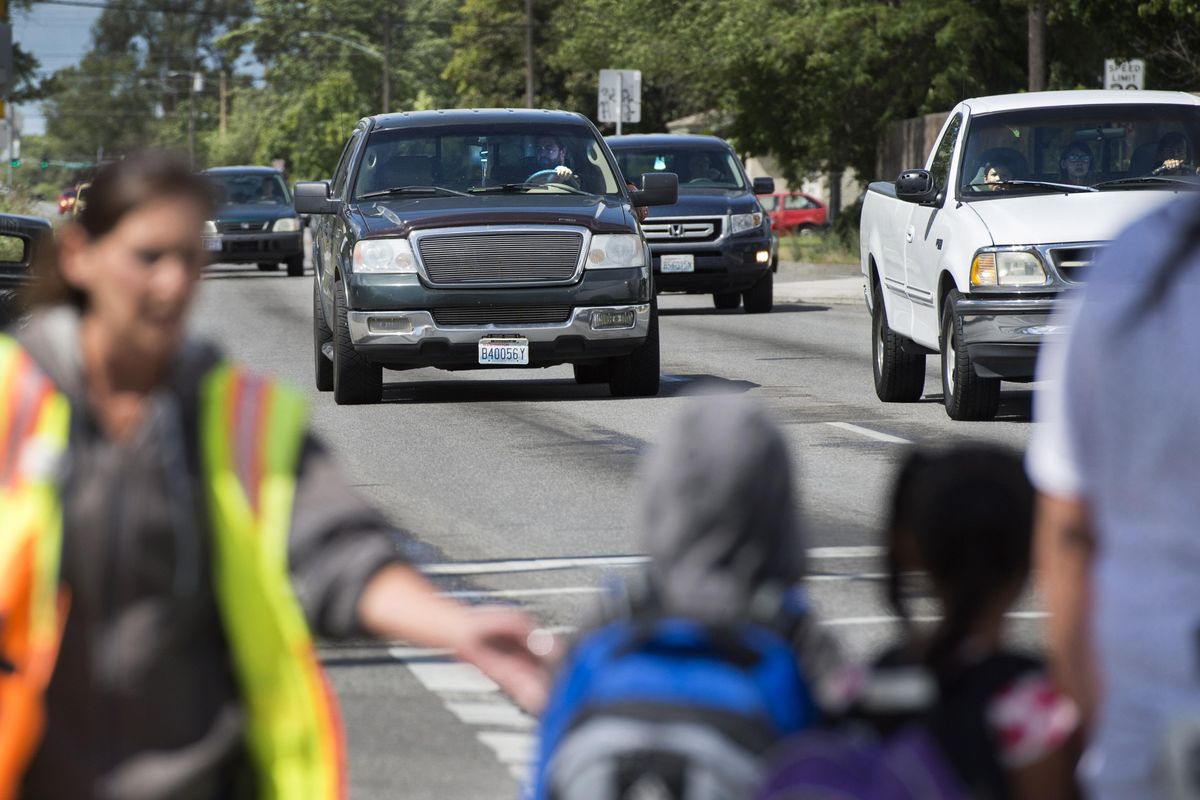Spokane’s two school zone cameras net over $1 million in fines

The rain let up Tuesday afternoon moments before a flood of traffic descended on Longfellow Elementary School in northeast Spokane.
When the bell rang and kids poured from the school, adults in cars jostled for position. The chaos and snarl of vehicles lasted about 15 minutes, enough time for Longfellow’s 530 students to find their ride, get on the bus or cross one of the many busy streets surrounding the school.
Through it all, traffic never let up on the busy, nearby arterials of North Nevada Street and East Empire Avenue.
At the beginning of the year, the city of Spokane began issuing tickets to drivers speeding near the school, a violation caught on camera as part of a new program similar to the city’s red-light cameras. Finch Elementary School also has a camera for school zone speeders.
Since January, 5,778 tickets have been issued near Longfellow and Finch. The tickets range from $234 to $450, meaning between $1.3 million and $2.5 million in fines have been assessed to drivers near those schools, where speed limits drop to 20 mph when children are present or warning lights are flashing. The vast majority of citations have been given near Longfellow, with 4,248 tickets issued since the beginning of the year. Finch generated 1,530 tickets.
At Longfellow, that equals about eight speeding tickets for every student.
“That’s fine with me,” said Patrick Anderson, whose daughter is in second grade at Longfellow. Anderson got a ticket from one of the cameras for going 33 mph. “People need to slow down. They should put them in in every school zone,” he said.
Mike Strantz, who had picked up his kindergarten grandson, was parked, waiting for traffic to let up.
“They don’t bother me that much,” Strantz said of the cameras. “You’re seeing the problem right now. People have to behave.”
Strantz said he supported the program, but worried the cameras weren’t accurate with their speed readings, an opinion shared by Lynn Campbell, who has already received two speeding tickets from the cameras.
“My kids think it’s because my car is yellow,” said Campbell, who was picking up her sixth-grade daughter and fourth-grade granddaughter. “People do speed, though. I do know people drive fast down Nevada. I do too when the lights aren’t flashing.”
Campbell and her husband, who works for the Postal Service, live “paycheck to paycheck,” and struggled to pay the first $264 ticket. She isn’t sure how they’ll pay for the second one, for $291.
“It’s outrageous,” she said, adding she may contest the ticket. “I do think they are a good thing, though.”
Spokane police Officer Teresa Fuller, who ran the school zone and red-light camera programs, said that about 55 percent of the school zone speeding tickets were issued to people driving, at most, 30 mph. Another 40 percent were going between 31 mph and 35 mph. Officer Craig Bulkley runs the programs now.
“It’s not about the money. It’s not about the tickets,” Fuller said. “It’s about safety.”
Fuller said someone’s chances of surviving being hit by a car drop quickly between 20 and 40 mph. At 20 mph, there’s a 95 percent chance of survival. At 30 mph, the chances are half and half. At 40 mph, you have just a 10 percent chance of living.
Spokane City Councilman Mike Fagan, who has been critical of using cameras to issue speeding tickets in the past, said he’s changed his mind.
“One of these days, somebody who is not paying attention is going to hit a kid and they’re going to kill somebody,” Fagan said. “Talk about a sad testament to drivers, their attitude and skills nowadays. It’s darn scary what’s going on out there.”
Fagan said the money generated by the program is split between Spokane Public Schools’ Safe Routes to School program and the city’s traffic-calming measures. Sidewalks on Five Mile Prairie and pedestrian timers at traffic signals have been paid for by the red-light program. Fuller said the programs, which are managed by Arizona-based American Traffic Solutions, are “completely violator-funded.”
Still, Fagan said he wants some of the money to pay for more police officers to patrol school zones so “people can actually see a police officer or vehicle or something else to give them pause and get them to slow down.” He added, however, “Aside from having a cheerleader standing underneath the ticket camera, we’ve done a pretty good job” of letting drivers know they’re entering a school zone with reduced speeds.
Fagan said he was worried his fellow council members would use the program to generate more revenue.
“Their reaction was, ‘Ka-ching, when can we put more of these speed cameras in school zones?’ ” Fagan said.
Still, Fagan is a convert to the cameras.
“My eyes have been made wide open on this issue,” Fagan said. “I just don’t know what else to say. People need to wake up and they need to pay attention.”
An earlier version of this article incorrectly identified the police officer who runs the city’s school zone and red-light camera programs. It is Officer Craig Bulkley.